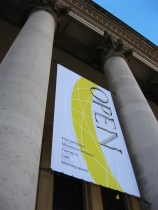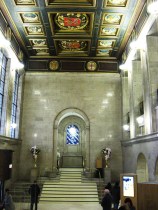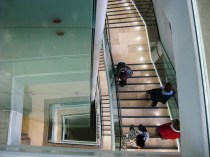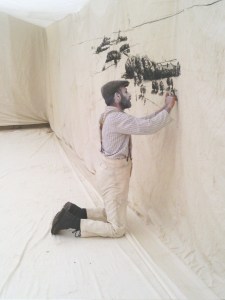 This weekend Boris Johnson, the darling of the Brexiteers and our illustrious Foreign Secretary told EU leaders to stop the ‘whinge-o-rama’ over Donald Trump’s victory in the US presidential election. Apparently some people, barely a week after a man who has told his supporters to punch protesters, refused to release his tax returns, has frequently used derogatory language, if not blatant sexual assault, against women, intends to build a wall between America and Mexico, has been bankrupt several times, doesn’t pay his contractors, accuses Hispanics of being drug dealers and rapists, doesn’t believe in global warming, has never had a job in government before and has never served in the forces (although he doesn’t have a problem with judging the family of a fallen soldier or describing a POW from his own party as a coward), mocks the disabled, and has really, really small hands (yep, I said it), are still complaining! How very dare they!!
This weekend Boris Johnson, the darling of the Brexiteers and our illustrious Foreign Secretary told EU leaders to stop the ‘whinge-o-rama’ over Donald Trump’s victory in the US presidential election. Apparently some people, barely a week after a man who has told his supporters to punch protesters, refused to release his tax returns, has frequently used derogatory language, if not blatant sexual assault, against women, intends to build a wall between America and Mexico, has been bankrupt several times, doesn’t pay his contractors, accuses Hispanics of being drug dealers and rapists, doesn’t believe in global warming, has never had a job in government before and has never served in the forces (although he doesn’t have a problem with judging the family of a fallen soldier or describing a POW from his own party as a coward), mocks the disabled, and has really, really small hands (yep, I said it), are still complaining! How very dare they!!
Of course we shouldn’t be that surprised that Donald’s British hair twin is telling people to forget about lies and racial overtones winning a vote – Johnson was one of the Brexit trio who used those very same techniques during the EU Referendum campaign earlier in the year (yes, it was only in June!). 
Full of their own overblown self importance, Johnson, Michael Gove and Nigel Farage became the poster boys for our leaving Europe in another ‘shock’ vote that seemed to illustrate just how divided both the UK and the US are. Unsurprisingly, Farage now seems to see himself as the self-appointed UK ambassador to the Trump administration and Johnson, who a few months ago was ‘worried’ by the idea of his presidency, doesn’t feel the need to attend a meeting with other EU countries to discuss the situation – even though we’re not out of the EU yet and due to the clusterfuck of a job our government is making of it, we won’t be for a while!
For those of us who voted remain and who find this new gift from 2016 pretty abhorrent, one question keeps rolling around our heads and it’s probably why we haven’t stopped whinging yet – why?
Now that’s a really big question and one that I definitely can’t answer. But to this lay(wo)man, it seems a couple of factors have surfaced that to apply to both Brexit and Trump:
All hail the new anti-establishment – the establishment

One of the arguments leveled against both Hilary Clinton and the remain campaign was that they are the establishment and that by voting against them you are taking your country back. What doesn’t seem to occur to voters, or they just don’t care, is that these people are also the establishment – some might say even more establishment than the people they’re attacking. Both Gove and Johnson are old Oxford boys, Farage was a merchant banker before he entered politics, and Trump was the son of another successful real estate developer, and who, by most accounts, helped his son get going with possible investments totaling millions of dollars. The idea that these men are ‘for the people, of the people’ seems a little incongruous – however, that’s the trick they’ve pulled off. My point here is not that the establishment always produces bad politicians or even that people in business cannot make good politicians, my point is that these white, middle-aged, very rich and/or upper-class men trade on the idea that they are anti-establishment when they are not. In fact, I would suggest that far from Trump being the blip, Obama was really the anomaly. What ever you think of them, his administration has brought in and encouraged major changes in American political society including the first legislation on healthcare since the 1960s and the legalisation of same-sex marriage across the country. Even Bill Clinton fell into the line of economically and socially conservative American presidents (except when it came to what happens in the Oval Office! Am I right???). The real radical in his administration was Hilary and she’s still suffering from that.
Tell it like it is… at least until you win
The day after Brexit, we were all a bit shell-shocked, including it seemed Johnson, who looked like he’d suddenly realised that perhaps he should have had a plan after all (this brilliant Downfall parody captures what may have happened). When President-elect Trump visited the White House to meet Obama (for the first time! How does that even happen???) some commentators suggested that even he finally felt the gravity of the situation and not just because Joe Biden was looking at him funny (for more of this hilarious #joebama meme see here or basically anywhere on the internet right now!).
The thing is that now he has to deliver and even if that doesn’t scare the shit out of him, the reality is that he simply won’t be able to, at least not enough to satisfy his most rabid supporters. As with Brexit, the practicalities of ‘what happens next’ are scarce. Even being looked after by experienced politicians in the oldest democracy in the world, leaving the EU is a complicated business which has led to Teresa May having to continually placate us with the phrase ‘Brexit means Brexit’ while not actually giving us a clue about what that means. It now looks like even when they do figure it out, the plan will have to be debated in Parliament which will further delay any actual action. Basically, it could take years despite the fact that the EU are telling us to just go already. In the States, Trump has the advantage of a Republican House and Senate and a conservative Supreme Court but even with those, things take time and lets not forget the mid-term elections are only two short years away. Sure, they can probably dismantle Obamacare but he’s already said he wants to keep some elements, and the ‘wall’, that may now have elements of fence-like activity in some parts, is highly unlikely to get built within the next four years plus it’s simply not possible for him to do some of the other things he promised because of a small thing called the Constitution (NPR have a round up of how and what he can achieve of his first hundred days promises here).
 Aside from this he’s already uncomfortably courting the LGBTQ community saying he doesn’t want to overturn equal marriage even though his VP believes in conversion therapy, he’s emphasizing deportation of criminal illegal immigrants over those seeking work, and denouncing the hate crimes that have risen significantly since his election despite having used inflammatory language in his campaign speeches and hired an alt-right, white supremacist sympathiser as chief strategist and senior counselor. Do I think all this means there won’t be that much damage? No, there will be, but it probably means he’s more in the realm of George ‘Dubya’ Bush than Hitler – as I’ve said, I believe he will prove to be a conservative, establishment President who will do what helps him and his pals keep making obscene amounts of money and keep most of the country dreaming of the trickle down economy while the people who will really suffer will be the ones that always have – minorities, women, the poor, and those of different sexual orientations.
Aside from this he’s already uncomfortably courting the LGBTQ community saying he doesn’t want to overturn equal marriage even though his VP believes in conversion therapy, he’s emphasizing deportation of criminal illegal immigrants over those seeking work, and denouncing the hate crimes that have risen significantly since his election despite having used inflammatory language in his campaign speeches and hired an alt-right, white supremacist sympathiser as chief strategist and senior counselor. Do I think all this means there won’t be that much damage? No, there will be, but it probably means he’s more in the realm of George ‘Dubya’ Bush than Hitler – as I’ve said, I believe he will prove to be a conservative, establishment President who will do what helps him and his pals keep making obscene amounts of money and keep most of the country dreaming of the trickle down economy while the people who will really suffer will be the ones that always have – minorities, women, the poor, and those of different sexual orientations.
It’s not me, it’s you
One of the main reasons media has given for the success of both Brexit and Trump is that the ‘liberal elite’ live in bubbles of their own creation where they neither know nor care about the rest of the country and assume that everyone loves soy lattes; that it’s only at times like these that we are forced to look beyond our quinoa salad and realise that a lot of people in the country are suffering, left behind, and feel un-listened to. This is the same media, by the way, that is sometimes unashamedly partisan, and sometimes a tasteless gruel that gives both sides of any argument equal time and credence even if one is proved to be on factual shaky ground.  The headline from the Brexit camp was that £350 million a week could be plowed into the NHS if we left which was found to be erroneous at best but was still plastered all over The Daily Mail and on the side of Boris’ bus. The culture of American news media in particular relies much more on opinion than fact and the idea that what you feel is more important than what’s actually true (for more on this see the concept of ‘Truthiness’ here). Of course, this does lead most of us to live in an echo chamber, following and reading people and opinions that chime with our own. I freely admit that I am part of that ‘liberal elite’ – a humanities post-graduate, living in a middle-class suburb of a vibrate, culturally rich city and working in a museum surrounded by people pretty much the same as myself. However, there are two points I’d like to make about this ‘bubble’ idea: Firstly, these are really big bubbles; In the EU Referendum 48% voted to remain – that’s not exactly a rout! And in the US Hilary won the popular vote and continues to add votes as they keep counting in larger states like California. So these ‘bubbles’ represent about half the country and they are vastly skewed towards younger voters meaning that a. if they continue to be engaged, it’s likely that they will win more votes in the future and b. that for the younger members of society, progressive social politics is a good thing. Secondly, why is it always us that are accused of not reaching out? The wonderful thing about global communication is that we can now have access to news from everywhere and on everything. In my ‘little’ bubble in a whole other country I knew about Hilary’s problems and they did give me pause to think but I also knew about Trump and his multitude of issues that were far worse than hers. Over Brexit, I knew and felt, that the EU is far from perfect but I didn’t trust the trio of Johnson, Gove, and Farage to have our interests at heart and felt it was better to work from inside rather than throw ourselves out. I’m not saying that I’m perfect, I’m just saying that access to these stories and facts are available to pretty much everyone. Can Trump voters claim to not know about his attitude towards women and immigrants? Surely not. And this is where it gets difficult, because while I’m willing to agree that not all Trump supporters are racists and misogynists, some are, and those people who aren’t have still put their hat in that ring. With Brexit, both campaigns were so woeful, it’s understandable (just) that some didn’t really know what they were voting for… but not 52% – they saw UKIPs shrouded and not so shrouded racism and Boris’ lies and still voted for them. Trump supporters held their noses and voted for somebody who has re-tweeted the KKK and rates women on how likely he is to sexually assault them. And that’s not even the policies! My ‘liberal elite’ have our problems and yes, maybe we should take more notice of what others in our country think – we should fight for better journalism and better politics but we should also fight for our values and our vision and people who are truly moderates need to make sure that they are heard too and don’t be so ready to vote for ‘your party’ no matter where they seem to be going.
The headline from the Brexit camp was that £350 million a week could be plowed into the NHS if we left which was found to be erroneous at best but was still plastered all over The Daily Mail and on the side of Boris’ bus. The culture of American news media in particular relies much more on opinion than fact and the idea that what you feel is more important than what’s actually true (for more on this see the concept of ‘Truthiness’ here). Of course, this does lead most of us to live in an echo chamber, following and reading people and opinions that chime with our own. I freely admit that I am part of that ‘liberal elite’ – a humanities post-graduate, living in a middle-class suburb of a vibrate, culturally rich city and working in a museum surrounded by people pretty much the same as myself. However, there are two points I’d like to make about this ‘bubble’ idea: Firstly, these are really big bubbles; In the EU Referendum 48% voted to remain – that’s not exactly a rout! And in the US Hilary won the popular vote and continues to add votes as they keep counting in larger states like California. So these ‘bubbles’ represent about half the country and they are vastly skewed towards younger voters meaning that a. if they continue to be engaged, it’s likely that they will win more votes in the future and b. that for the younger members of society, progressive social politics is a good thing. Secondly, why is it always us that are accused of not reaching out? The wonderful thing about global communication is that we can now have access to news from everywhere and on everything. In my ‘little’ bubble in a whole other country I knew about Hilary’s problems and they did give me pause to think but I also knew about Trump and his multitude of issues that were far worse than hers. Over Brexit, I knew and felt, that the EU is far from perfect but I didn’t trust the trio of Johnson, Gove, and Farage to have our interests at heart and felt it was better to work from inside rather than throw ourselves out. I’m not saying that I’m perfect, I’m just saying that access to these stories and facts are available to pretty much everyone. Can Trump voters claim to not know about his attitude towards women and immigrants? Surely not. And this is where it gets difficult, because while I’m willing to agree that not all Trump supporters are racists and misogynists, some are, and those people who aren’t have still put their hat in that ring. With Brexit, both campaigns were so woeful, it’s understandable (just) that some didn’t really know what they were voting for… but not 52% – they saw UKIPs shrouded and not so shrouded racism and Boris’ lies and still voted for them. Trump supporters held their noses and voted for somebody who has re-tweeted the KKK and rates women on how likely he is to sexually assault them. And that’s not even the policies! My ‘liberal elite’ have our problems and yes, maybe we should take more notice of what others in our country think – we should fight for better journalism and better politics but we should also fight for our values and our vision and people who are truly moderates need to make sure that they are heard too and don’t be so ready to vote for ‘your party’ no matter where they seem to be going.
So where do we go from here? My main issue with all of this is not policy – as I’ve said I think Trump will prove to be a conservative Republican and Bexit could take years and let’s face it, we’re still going to be able to buy brie. My fear is that Trump and Brexit have legitimised certain attitudes that I had hoped had faded into the past. These attitudes range from wishing the world would stand still or return to a time when people knew where they stood to all out fascism. Many people are scared by the rapid social change both here and across the pond, including some of us liberals. While we may agree with the progression of gender and civil rights the era of globalisation has brought, the unbridled global capitalism that prospered the banking crisis and huge conglomerates are certainly not on my wish list. But whether we can have one without the other is a question for another time. Right now us liberals need to not give up in our feeling of loss – in or out of Europe or with Trump as president, we can promote what we want to see through our own actions every day – if you see racism or harassment, stand up to it; keep or get engaged with politics and encourage others to do the same; vote; volunteer; donate; talk about your values and how you see the future – you don’t have to shove it down peoples throats but be sure in your conviction that to make the world a better place it needs to be more inclusive not less. For moderates, try to understand that you can make choices and that choice is better for everyone; fight for your voices to be heard in all parties and arguments; don’t be so scared of those who are different from you; if you don’t know, find out; vote based on your beliefs not just party affiliation; do some research – it’s out there but you have to find it (that’s kind of what being a citizen is about).
Do I think a lefty utopia is just around the corner? No, and that’s not even what I’m suggesting. As Winston Churchill said:
Many forms of Government have been tried, and will be tried in this world of sin and woe. No one pretends that democracy is perfect or all-wise. Indeed it has been said that democracy is the worst form of Government except for all those other forms that have been tried from time to time.…
So, if like so many other things in our world, Democracy is the best idea we have at the moment, lets give it a proper go in both my beautiful, diverse, messy countries and maybe, just maybe, we can all learn to get along a little easier.



















